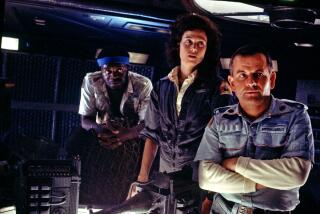Influential ‘Alien’ probed culture’s darkest fears
Why has Ridley Scott’s 1979 science-fiction splatterfest “Alien” -- released today in a digitally remastered director’s cut -- proved to be such a durable and influential piece of filmmaking?
“Alien” is all about “the dark side of technology, of science,” says David J. Skal, author of “The Monster Show: A Cultural History of Horror.” “Despite all the things we’re told that will make the future a better place, what happens in ‘Alien’ is our worst nightmare.”
That’s exactly what Dan O’Bannon was thinking when he set out to write what he calls “a scary spaceship movie” in the mid-1970s. Influenced by 1950s sci-fi films like “The Thing,” O’Bannon was determined to make a “monster thriller about a monster from outer space, done with the style and technology that had accumulated since the 1950s.”
This merger of horror and science fiction proved extremely fortuitous. There had been plenty of monsters in movies before “Alien,” but mostly they had been of the “man in rubber suit” variety. Thanks to the creepy vision of Swiss artist H.R. Giger, the extraterrestrial monster in Scott’s film, with its insect-like body, acidic blood and knife-sharp teeth, was truly nightmarish.
“The H.R. Giger alien was like nothing you’d ever seen before,” says Gordon Van Gelder, editor of Fantasy & Science Fiction magazine. “ ‘Alien’ was the first film that put the splatter element into a sci-fi context.”
“The monster is skeletal, it’s mechanical, it’s insect-like,” Skal says. “It’s all of this stuff hitting you at once, and it’s bound to elicit a response from the viewer.”
Thanks in part to an innovative marketing campaign -- the tagline “In space, no one can hear you scream” might be one the best ever devised -- that response translated into a $79-million domestic box-office gross (huge for the time), three sequels and stardom for Sigourney Weaver, whose sexy but no-nonsense Ripley became a template for all subsequent female action heroes.
And the film itself became a model of sorts. Take a sexually and racially diverse crew; place them in an out-of-the-way space station, planet or underwater research facility; then have them menaced by a horrific creature until there is only one man, or woman, left standing -- “Leviathan,” “Deep Blue,” “Event Horizon,” “Pitch Black,” “Screamers,” the list of films seems to go on endlessly, and in a sense, that’s the problem.
“Alien’s” basic premise was so successful, it “exhausts the genre,” O’Bannon says. “No one seems to be able to get past it, which is why it has had a dire effect on every movie since then.”
Certainly, as Van Gelder puts it, “Hollywood found a formula that works, and they haven’t expanded on it all that much.” But Skal says the fault lies as much with the nature of cinema itself.
Yet even if “Alien” helped freeze the sci-fi/horror film in a creative stasis, it has proved groundbreaking in other ways. Scott’s cool, cerebral direction makes the horror elements in the movie seem even more frightening. The sequences in which Yaphet Kotto and Harry Dean Stanton gripe about their labor contracts, injecting a class consciousness into the story, was totally innovative at the time, and remains so today.
But it’s the film’s Oscar-winning production design that has had the most impact. The contrast between the ascetic-looking interiors of the spaceship Nostromo and the baroque alien craft, with its dark, looming beauty, helps give the film much of its creepy power. Certainly the influence of Giger’s dark vision can be seen in “The Matrix” and other sci-fi productions.
Still, Skal feels that the film ultimately holds up because of the way it plugs into atavistic fears.
“It’s an impossible nightmare, this fusion of technology and vermin, death and sex,” he says. “It goes back to what monsters are: They’re always a fusion of contradictory aspects. They’re things that don’t exist and can’t exist, but they work on a dream level; they capture our imaginations.”
More to Read
Only good movies
Get the Indie Focus newsletter, Mark Olsen's weekly guide to the world of cinema.
You may occasionally receive promotional content from the Los Angeles Times.










